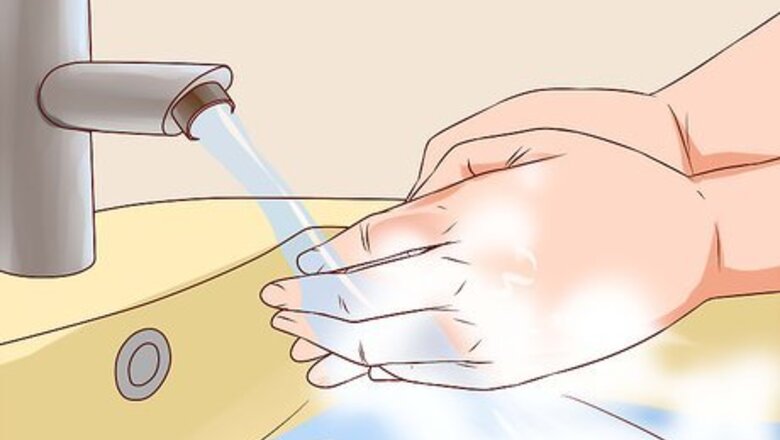
views
Preparing Your Tools and Work Area

Ensure a clean work area. Shots penetrate the body's most important defense against disease – the skin. Because of this, care must be taken to prevent the transmission of germs that cause infection. Begin by washing the area where you will set your materials with soap and water. Wash, dry, and disinfect your hands thoroughly.
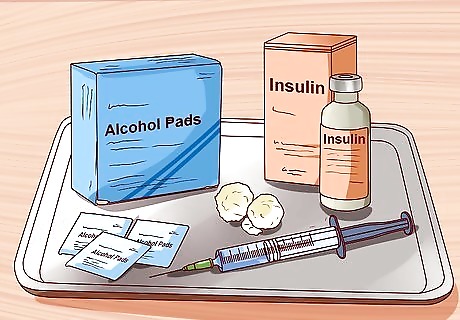
Gather your materials. On a clean tray, table, or counter top, lay out the drug to be injected, cotton balls, bandages, alcohol wipes, and a sealed disposable syringe with an unused needle. Additionally, make sure you have a dedicated sharps/biohazard disposal container nearby. You may want to lay down a sterile paper liner or a clean paper towel beforehand for ease of clean-up. Set out your tools in the order you’ll use them in. For example, set your alcohol wipes closest to you, followed by the medicine, the syringe and needle, then, finally, cotton balls and/or bandages.
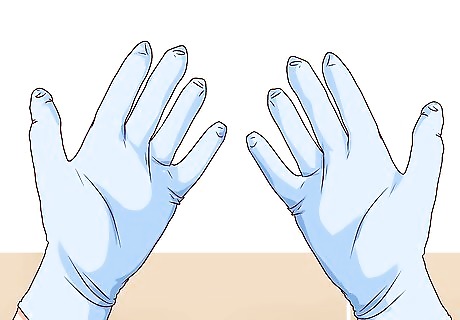
Put on clean, disposable gloves. Even though your hands have already been carefully washed, as an added precaution, it's wise to wear disposable gloves. If, at any point, you touch an unclean object or surface, rub your eye, itch yourself, etc., discard and replace your gloves. To minimize the chance of your gloves getting contaminated, wait to put them on until right before you deliver the injection.
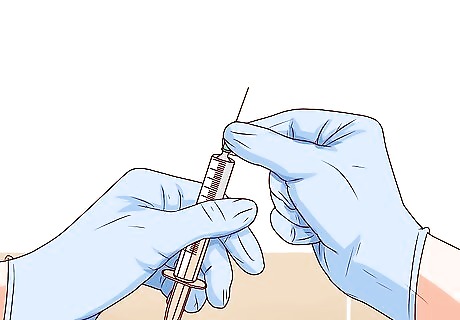
Read your dosage 3 times. Take plenty of time to read the dosage instructions and make sure you understand them. Some medicines can have very precise dosages, and giving too much of the medication may cause harmful side effects. Before proceeding, make sure you know exactly how much medicine you'll be administering in the shot – this information should have been provided by the physician and/or included on the prescription. Also, make sure your syringe is large enough to accommodate your dose and that you have enough medicine to give a full dose. Call your doctor or pharmacist if you have any questions about the dosage.
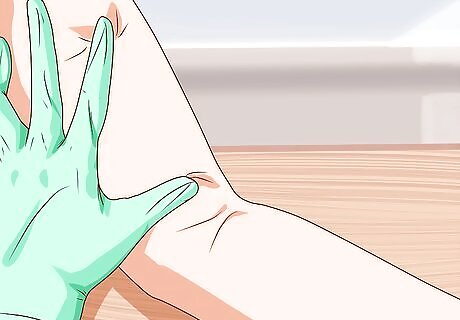
Pick an injection site. Your site will depend on what type of injection you're doing. If you're doing an SQ injection, such as an insulin or heparin shot, pick a spot where there's a fatty layer beneath the skin. These locations include the backs of your arms, your sides, your lower belly (2 finger-widths below the belly button), and your thighs. Pick a spot that is at least 1 inch (2.54 cm) from the location of your last injection, especially if you receive frequent injections. This safety practice is called "rotation". Rotation is done to avoid complications such as bruising or lipodystrophy (a condition where the skin becomes lumpy or misshapen at the site of repeated injections).
Drawing a Dose

Remove the vial's cap. Usually, medications given via subcutaneous injection come in small vials with an outer lid and an inner rubber diaphragm. Take the lid off of the vial and disinfect the rubber top with a cotton ball soaked in alcohol or an alcohol wipe. After wiping the top of the vial with alcohol, allow it to air dry for a few seconds.
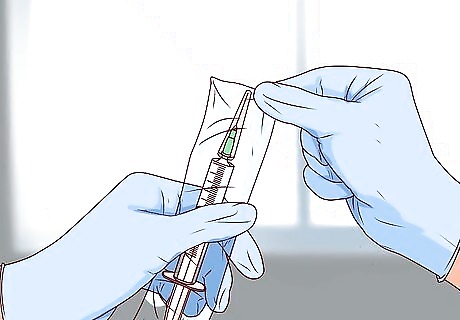
Open your sealed syringe. Modern subcutaneous injections are given with sealed, disposable needles to lessen the chance of infection. Remove your needle and syringe from its casing. From this point on, handle the needle and syringe with care. If the needle touches anything that hasn't been sterilized, don't risk infection by proceeding to use it for the injection. Instead, replace it with a new one. This is a good time to double check the name on the bottle, the patient’s name, and the dosage. If your syringe doesn't come with the needle attached, you may need to gently insert and/or screw the needle onto the end of the syringe. Do this before removing the needle's cap.
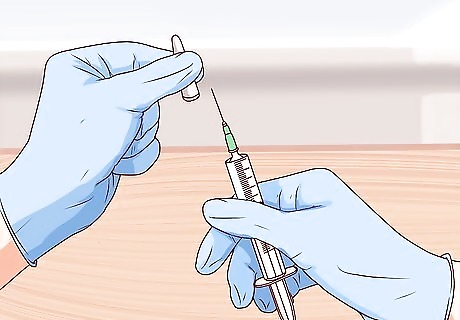
Remove the cap of the needle. Grasp the needle's protective cap by pulling firmly outward. Do not touch the needle now or at any point during the following steps. Handle the needle with care.
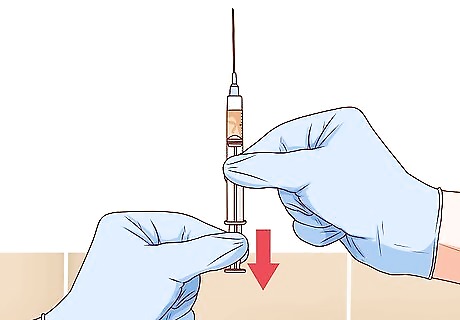
Pull the syringe plunger to the desired dosage. The barrel of the syringe has dosage measurements on the side. Line the plunger up with the precise measurement for your dosage. As you do this, air will be drawn into the syringe. This is important because you won't be able to draw any medication from the vial unless you pump air into it first.
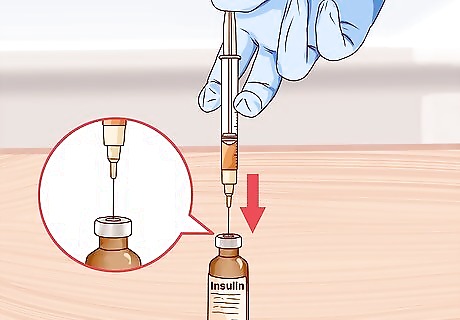
Insert the needle into the vial. Set the vial on a flat surface and carefully stab the needle through the vial's rubber diaphragm so that the needle's point is inside the vial.

Depress the plunger. Push down on the plunger. Do this gently, but definitively. Do not leave any air in the syringe. This action pushes air into the vial. Adding air to the vial serves an important purpose. By putting air in the vial, you increase the air pressure in the vial, which will make it possible and easier to draw the correct dose because the extra air helps "push" the liquid out. Although this is standard practice with most injections, it’s not necessary with insulin or heparin.
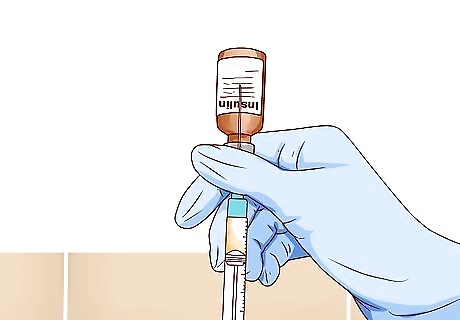
Pick the vial up. Carefully hold the vial in one hand and the syringe in the other. Turn the vial upside down in the air with the needle still inside. The syringe should be beneath the upside-down vial with its needle pointing up into it. Make sure that the liquid medication covers the needle so you won't draw in any air bubbles.
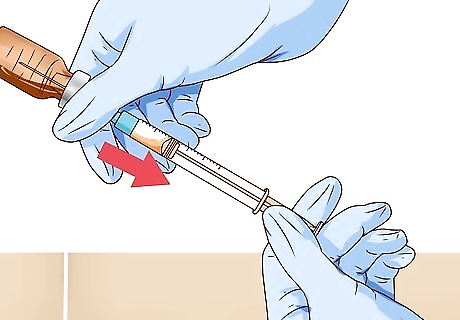
Draw your dose. Pull the plunger toward you to fill the syringe with your prescribed dosage. Make minute adjustments as necessary by gently pushing or pulling on the plunger to ensure the amount of medicine in the syringe is exactly correct. When you're done, take the needle out of the vial. Set the vial aside for future doses or dispose of it in a proper medical waste receptacle.
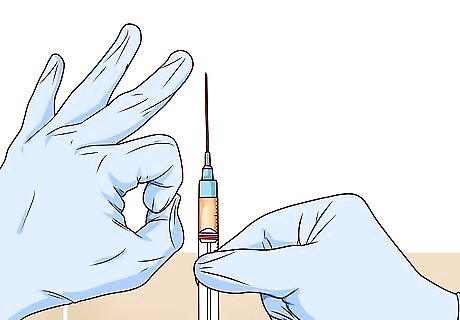
Aspirate the syringe. Hold the syringe needle-up and flick the side of the syringe to cause any bubbles to float to the top. When you've dislodged all the bubbles in the syringe, gently depress the plunger until all the air leaves the syringe. You can stop when you see a tiny drop of liquid emerge from the tip of the needle. Check to make sure there’s enough medicine left for a full dose after aspiration. It’s easy to expel too much medication, especially with a small injection like an insulin shot. If you have to, go back and add a little more, then repeat the process. The tiny amount of air that can get trapped in a syringe is not large enough to cause serious harm if it is injected into the patient’s body by accident. A trapped bubble injected under the skin could cause bruising, however.
Giving the Shot

Disinfect the injection site. Wipe your chosen injection site with a cotton ball soaked in alcohol or with a pre-packaged alcohol wipe. Alcohol kills germs and microorganisms on the skin, reducing the risk that the needle will carry them under the skin.
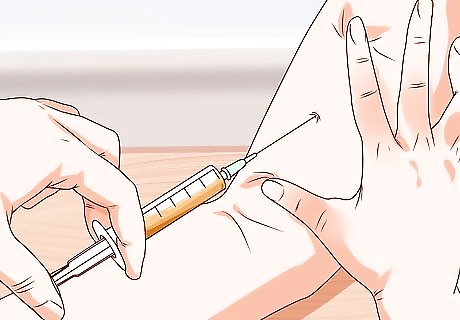
Hold the syringe with one hand. Use your other hand to pinch your flesh where the shot will be given. This causes a "bulge" in the fatty tissue, which gives you a thicker area to safely inject into.
Stick the needle into the skin at a 90° angle for IM and SQ shots. Hold the needle like a dart and plunge the needle into the spot you've pinched. Don’t worry about rushing the process, just deliver the injection at a speed you feel comfortable with. If you're doing an SQ shot and your patient does not have a lot of body fat, make sure to gently pinch the skin and hold it away from the muscle before delivering the shot.
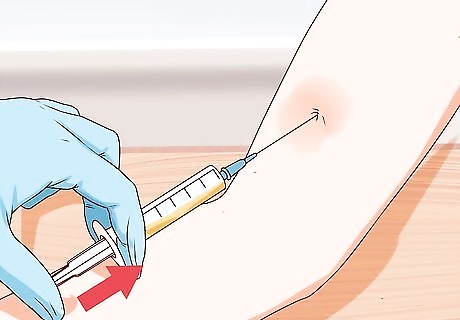
Administer the drug. Release the drug into the subcutaneous layer by slowly pushing down on the plunger. Push at a steady, controlled pace. Some minor discomfort is normal at this point. To get the timing right, try counting to 3. Start injecting on 1, then count out 2 and 3 as you push in the plunger the rest of the way.

Remove the needle from the patient’s skin and discard it. Gently but confidently pull the needle out of the patient’s skin. Before doing anything else, dispose of the needle in a labeled sharps container. Don’t recap the needle before throwing it away. Once you’ve delivered the injection, the needle is dirty and is considered a biohazard. Handle the used needle carefully, since this is the part of the process where most accidental needle sticks occur. After you remove the needle and throw it away, apply gentle pressure to the injection site with a clean cotton ball.
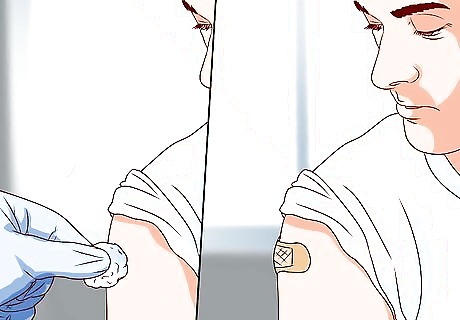
Bandage the injection site. Apply a dry cotton ball to the injection wound. If desired, you may use a bandage to hold this against the wound, or you may hold it in place yourself, taking care not to touch the wound, and discard it when bleeding stops.

Dispose of the cotton balls, needle and syringe appropriately in a sharps bin. Place any contaminated material in a sturdy, clearly-marked container. Clean your work area and put away your tools. If you don’t have a specially marked “sharps bin” or a sharps disposal program in your area, you can safely dispose of your used needles in sturdy container with a lid, such as a milk jug or detergent bottle. Tape the lid on before placing the container in your garbage. In many areas, you can dispose of your sharps bin at a pharmacy.










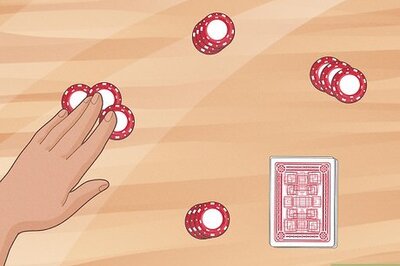









Comments
0 comment